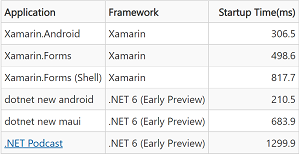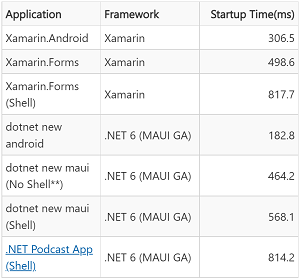[ad_1]
Information
.NET MAUI Devs Wrestled with iOS App Measurement, Android Startup

Microsoft struggled to enhance .NET MAUI efficiency past that of Xamarin.Types, wrestling with thorny points like iOS app dimension and Android startup occasions.
In response to a prolonged, painstakingly detailed weblog put up about these struggles, it labored for .NET MAUI (.NET Multi-application UI), which simply hit Basic Availability standing on its path to interchange Xamarin.Types, together with the flexibility to create desktop apps along with cell apps.
“Our objective was for .NET MAUI to be quicker than its predecessor, Xamarin.Types, and it was clear that we had some work to do in .NET MAUI itself,” stated Jonathan Peppers, senior software program engineer, in a gargantuan June 7 put up titled “Efficiency Enhancements in .NET MAUI.”
He stated the crew believed that good points in developer productiveness should not come at the price of software efficiency.
“The identical could possibly be stated about software dimension — what overhead is current in a clean .NET MAUI software? Once we started optimizing .NET MAUI, it was clear that iOS had some work wanted to enhance software dimension, whereas Android was missing in startup efficiency,” he continued.
To strike a stability between app dimension and startup efficiency, the crew addressed a dizzying array of considerations with many exams and tweaks that fine-tuned features starting from completely different sorts of ahead-of-time (AOT) compilation to lazy loading to Dependency Injection to optimized colour parsing and lots of extra.
Take AOT, for instance, an enormous sticking level within the .NET world as the dearth of formally supported native AOT really saved builders away from the framework, in line with a 2020 Microsoft survey.
AOT was discovered to be quicker than simply in time (JIT) compilation, because the latter occurs the primary time every C# technique known as and thus implicitly impacts startup efficiency, which is a big concern in cell apps. Nevertheless, AOT will increase app dimension, as a result of, for instance, an Android native library is added within the last app for each .NET meeting, boosting the quantity of code that must be loaded up. This conundrum required a balanced trade-off, a compromise that is prevalent in software program growth.
“To offer one of the best of each worlds, startup tracing or Profiled AOT is a present characteristic of Xamarin.Android,” Peppers stated. “This can be a mechanism for AOT’ing the startup path of purposes, which improves launch occasions considerably with solely a modest app dimension enhance.
“It made full sense for this to be the default choice for Launch builds in .NET 6. Up to now, the Android NDK was required (a a number of gigabyte obtain) for doing AOT of any variety with Xamarin.Android. We did the legwork for constructing AOT’d purposes with out an Android NDK put in, making it attainable to be the default going ahead.”
By that and plenty of different optimizations, the crew did certainly decrease startup occasions, as evidenced by the 2 graphics under, the primary one exhibiting check outcomes for Android startup occasions in early previews, whereas the second exhibits efficiency enhancements “after the mud settled.”


“To reach at the place we’re right this moment, it was a collaboration of a number of completely different groups,” Peppers stated. “We improved areas like Microsoft.Extensions and DependencyInjection utilization, AOT compilation, Java interop, XAML, code in .NET MAUI on the whole, and plenty of extra.”
Whereas a number of builders lauded the crew’s efforts within the feedback part of the weblog put up, one took exception, claiming efficiency boosts are secondary to extra vital considerations like lacking options and performance.
“Presently there are lots of instances the place an API on a platform does nothing however [is] documented as working,” stated the remark. “Most significantly Necessities APIs. E.g. taking images on Home windows does nothing. Processing photographs utilizing Maui.Graphics on Home windows does nothing as a result of they can’t be loaded as IImage (not absolutely carried out)! How can this be a full launch? How will you launch a characteristic that doesn’t work — taking take a look at the publicly obtainable supply code and seeing solely components carried out? I do not perceive this habits with MAUI.”
Concerning the Creator
David Ramel is an editor and author for Converge360.
[ad_2]
Supply hyperlink